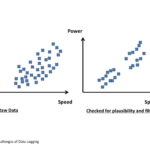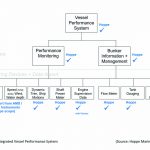
As bunker costs have increased and software has matured beyond nice graphs, monitoring systems become inevitable. By Hauke Hendricks, Jens W. Hinsch and Michael vom Baur from Hoppe Marine
Why investing in a performance monitoring system?
The costs for bunker fuels have increased d[ds_preview]uring the past years by factor four and more and will very likely stay on high level in the future. For operators using own ships the fuel costs are now by far the largest part of the total operation cost. Thus, no drop of fuel is to be wasted! Operators using vessels on time charter base prefer more and more ships with transparent performance monitoring and bunker fuel management, in order to keep control of the fuel costs on a ship which is operated by a third party crew. Having effective and transparent performance monitoring tools or even a comprehensive vessel performance system on board becomes increasingly a competitive advantage of shipowners towards large charterers. Performance monitoring tools can also provide efficient functions to comply with new regulatory burdens, e.g. for the mandatory Energy Efficiency Operation Index (EEOI) and Ship Energy Efficiency Management Plan (SEEMP) reporting.
The investment for performance monitoring tools or even a complete vessel performance system would be in the magnitude of 20,000–200,000 € per vessel depending on required functional level, existing sensors of sufficient quality and ship size and is thus small compared to the possible savings. The return on investment is typically below one year.
Performance monitoring: Just a software task producing nice graphs?
As for many other aspects of ship operation, the task of performance monitoring appears to be simple at first glance, but »the devil is in the detail«. The quality and plausibility of the measured data is the key for the relevance of performance monitoring results.
The challenge becomes evident with the following example:
A variation of 0.1 kn in GPS-provided ship speed over ground (SOG), as it can always easily happen everywhere due to current influences, is equivalent to a variation in shaft power of approximately 2 %, which is, on the other hand, often the magnitude of the possible savings under the actual circumstances. Another example is the fact that the trim during sailing (»dynamic trim«) may deviate by several decimeters from the trim measured in port (»static trim«), being also different for different speed levels. This may eventually result in quite different flow conditions around the bulbous bow, which have a significant impact in defining the shaft power demand. Parameters such as rudder angle and ship motions have a strong influence on the comparability of recorded performance data. This is why shipowners are often confronted with a »cloud« of measured points in their speed-power diagram rather than a curve (Fig. 1). Simply applying lump sum statistical methods on random data without careful judging the individual influence parameters may lead to doubtful results. Therefore, only using the best available sensors as well as a continuous logging and plausibility checking of all operational data plus the relevant influencing factors such as actual dynamic floating condition, water depth, rudder angle, as well as weather and ship motions provide a reliable basis for relevant quantitative performance monitoring results. On this background the »crunching of data« obtained from each
and every source in a software system may sometimes provide rough indication only rather than reliable quantitative results or may even be, in worst case, misleading.
How to get started?
In principle, performance monitoring can be started by simple measures on a manual base. Definitely needed are an as precise as possible measuring device for speed through water (STW), GPS and a quality shaft power meter (SPM), which should have the capability to be zero checked and re-calibrated at any time. Hoppe Marine’s Maihak SPM has this capability and is not sensitive to changing ambient conditions or vibrations. Since it can be easily dismantled and mounted again, the Maihak SPM is the perfect device for yard’s sea trials for the proof of the vessel’s Energy Efficiency Design Index (EEDI). For this reason the Maihak SPM is a preferred choice of Maersk. Combined with Hoppe’s PLC substation HOMIP, which can import nautical, speed and fuel counter data, a simple data logging can be performed and basic key performance indicators (KPI) such as specific fuel oil consumption (SFOC in g/kWh), vessel efficiency (kg/nm) and voyage fuel consumption (ton/voyage) can be stored and indicated on the PLC display. We call this first step »power and performance meter«.
Of course manual recordings of wind and wave conditions as well as draft, static trim and eventual shallow draft areas have to complement the data logging. Since this requires quite some work and dedication for the crew and still is a rough recording only, we recommend going at least the next step (Fig. 2).
A Maihak Performance Monitoring System, which runs on a database server gaining data from the HOMIP PLC level, is able to log and process additional data, including rudder angle and water depth, to indicate and report more extensive KPIs and to generate noon, voyage and SEEMP reports. Automatic data transmission to a shore-based server, e.g. in the operator’s office, can be provided. Bernhard Schulte is using Maihak Performance Monitoring features on several ships, since they make the demanding fuel reporting to their charterers more easy and transparent.
To enable more accurate comparisons for performance analysis and optimisation tasks, ship motions as well as dynamic trim data can be also integrated, if the performance meter would be connected to Hoppe’s proprietary Inertial Motion Measuring System (HOSIM). The core of HOSIM is a cost-efficient multi-use sensor unit with sophisticated Kalman filter post-processing, which has been optimised for maritime use.
Once HOSIM is installed on board, not only motions and dynamic trim can be measured, but also other optional functions such as dynamic inclinometer (upcoming IMO requirement!), cargo lashing supervision (accelerations) and (with at least two HOSIM measuring points over the ship length) dynamic hull deformation monitoring (torsion, bending) can be enabled by the same sensor.
The euromax container vessel »Charcot« (2,500 TEU, Passatwind Reederei), on which the first Maihak Performance Monitoring System plus HOSIM was installed in September 2011, has reported around 5 % fuel savings due to manual trim optimisation, based on the logged data and several voyage comparisons. Based on the performance monitoring system, Hoppe Marine offers also trim optimising assistance functions, which can either use data of optimum trim depending on displacement and speed and available from model tests or CFD computations or build up a database of best trim information gained from logged and carefully post-processed comparable operational data (concept of »permanent trial trip«).
For dynamic trim measurement Hoppe has also an alternative measuring system (TRIMCON), which works on GPS-base with stations fore and aft, which additionally enable conning supervision.
Bunker management complements performance monitoring
Since the fuel consumption considered in the above described performance monitoring is based on fuel counters (with all their known challenges such as backflush, vibrations, wear & tear etc.), a better way of controlling the fuel consumption would be the parallel implementation of a Hoppe Marine Bunker Management System (Fig. 3).
This system basically collects data from all tank content sensors in the vessel’s fuel system and some Hoppe HOCOR mass flow meters in key positions. It can also be easily added to a hydrostatic Hoppe Tank Gauging System and provides not only a seamless fuel mass balance and bunker intake check as well as the related reports, but in combination with Hoppe’s Maihak Performance Monitoring also a comprehensive, double- checked and plausible energy balancing. Since third quarter 2012 the unique Hoppe Bunker Management System is being installed on ten container vessels of the »Hamburg Express«-class (13,169 TEU, Fig. 5) and meanwhile successfully helped to better understand the frequent challenges of fuel measurement and bunker reports.
Trend: Integrated vessel performance systems
Taking recent ship operator experiences as well as demand of major owners and charterers into account, a trend towards the fuel and energy-optimised »transparent ship« can be expected. This calls for an integrated vessel performance system (IVPS, Fig. 4), which provides comprehensive monitoring, optimisation assistance and reporting features, also including the propulsion and power plant data (main + auxiliary engines).
Hoppe Marine is already working on first projects of this kind and can offer complete system solutions with full vertical responsibility along the measuring and processing chain, backed by more than 60 years of experience in on-board measuring technologies.
The features of future integrated systems will go even further down into details such as optimising the fuel consumption and energy efficiency of auxiliary systems (e.g. optimum combined operation of Diesel generator sets) and aggregates. For several of these tasks Hoppe Marine has developed first pilot solutions. The common objective with shipowners and operators is not to waste any drop of fuel, for the sake of competitive ship operation as well as for a clean environment!
Hauke Hendricks, Jens W. Hinsch, Michael vom Baur























